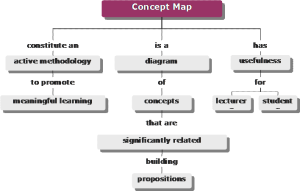3 Concept mapping
What is concept mapping?
 Concept mapping is a graphical tools that help organize and represent key concepts in a framework and how they relate to one another. It is a visualization of integrating new knowledge with relevant knowledge that one already possesses. Doing so can help learners develop links between old and new concepts. This occurs best when students receive feedback on their concept maps in regards to the content and the process of creating one. This also promotes active learning instead of simple rote memorization of ideas.
Concept mapping is a graphical tools that help organize and represent key concepts in a framework and how they relate to one another. It is a visualization of integrating new knowledge with relevant knowledge that one already possesses. Doing so can help learners develop links between old and new concepts. This occurs best when students receive feedback on their concept maps in regards to the content and the process of creating one. This also promotes active learning instead of simple rote memorization of ideas.
How can you use concept mapping in your course?
Concept maps are best used towards the end of a unit or when the learner has enough knowledge of the domain to construct such a map. It is important to define the area of knowledge to be mapped, whicf is done best by preparing a focus question that will be answered by the knowledge on the map. Good focus questions require explanation rather than simple description or classification. Concept maps should not just be added on to the end of a unit. They should be used thoughtfully and with a purpose to support student learning. Creating a concept map without a focus question or a specific goal in mind can result in students focusing on the wrong ideas or generating a concept map that is too broad to be useful in studying.
Good focus questions: How do flowers create energy? How can we help teachers become more effective?
Less useful focus questions: What are the key features of a flower? What are the common traits of effective teachers?
Once learners have the focus question, they should identify the important concepts necessary to answer the question. As learners begin to construct their concept maps, they should add linking words to the lines connecting concepts. These words should specify the relationship between the concepts. In doing so, learners can simplify complex relationships, better organize their thoughts around a topic, and begin to connect themes and ideas across course content.
Concept maps should not just be added on to the end of a unit. They should be used thoughtfully and with a purpose to support student learning. Creating a concept map without a focus question or a specific goal in mind can result in students focusing on the wrong ideas or generating a concept map that is too broad to be useful in studying.
What results can you expect from incorporating concept mapping into your course?
Concept mapping has generally positive effects on student achievement and experience. Concept maps can help students move from rote memorization to thinking critically about complex phenomena and their relationships. Concept maping has been shown to improve student performance on assessment and reduce their anxiety.
Who can help if you’re interested in incorporating concept mapping into your course?
For more information, please consult the following resources:
Theoretical origins of concept maps, how to construct them, and uses in education
An investigation of the effectiveness of concept mapping as an instructional tool
If you would like to explore how you could use this in your course, please reach out to the Center for Teaching for assistance and guidance on how best to implement these activities.
